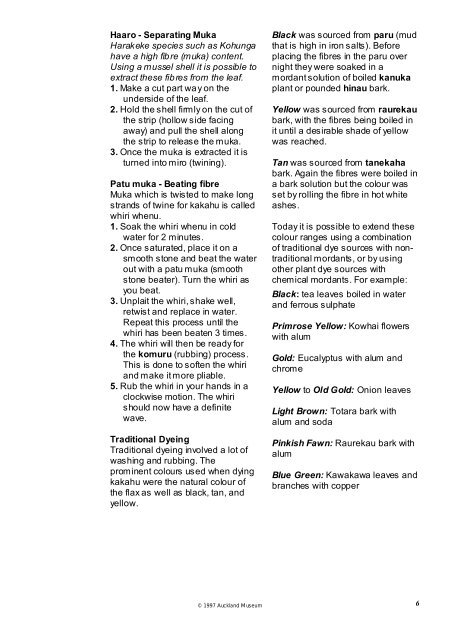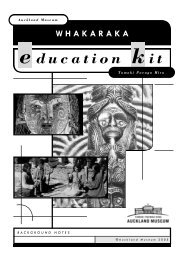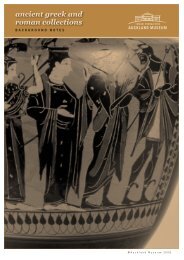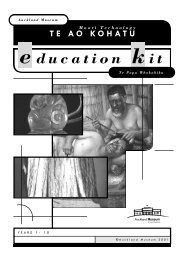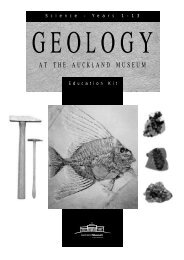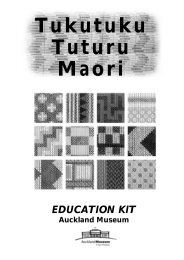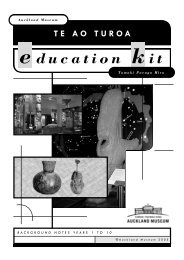Raranga Tuturu Maori - Auckland Museum
Raranga Tuturu Maori - Auckland Museum
Raranga Tuturu Maori - Auckland Museum
Create successful ePaper yourself
Turn your PDF publications into a flip-book with our unique Google optimized e-Paper software.
Haaro - Separating Muka<br />
Harakeke species such as Kohunga<br />
have a high fibre (muka) content.<br />
Using a mussel shell it is possible to<br />
extract these fibres from the leaf.<br />
1. Make a cut part way on the<br />
underside of the leaf.<br />
2. Hold the shell firmly on the cut of<br />
the strip (hollow side facing<br />
away) and pull the shell along<br />
the strip to release the muka.<br />
3. Once the muka is extracted it is<br />
turned into miro (twining).<br />
Patu muka - Beating fibre<br />
Muka which is twisted to make long<br />
strands of twine for kakahu is called<br />
whiri whenu.<br />
1. Soak the whiri whenu in cold<br />
water for 2 minutes.<br />
2. Once saturated, place it on a<br />
smooth stone and beat the water<br />
out with a patu muka (smooth<br />
stone beater). Turn the whiri as<br />
you beat.<br />
3. Unplait the whiri, shake well,<br />
retwist and replace in water.<br />
Repeat this process until the<br />
whiri has been beaten 3 times.<br />
4. The whiri will then be ready for<br />
the komuru (rubbing) process.<br />
This is done to soften the whiri<br />
and make it more pliable.<br />
5. Rub the whiri in your hands in a<br />
clockwise motion. The whiri<br />
should now have a definite<br />
wave.<br />
Traditional Dyeing<br />
Traditional dyeing involved a lot of<br />
washing and rubbing. The<br />
prominent colours used when dying<br />
kakahu were the natural colour of<br />
the flax as well as black, tan, and<br />
yellow.<br />
© 1997 <strong>Auckland</strong> <strong>Museum</strong><br />
Black was sourced from paru (mud<br />
that is high in iron salts). Before<br />
placing the fibres in the paru over<br />
night they were soaked in a<br />
mordant solution of boiled kanuka<br />
plant or pounded hinau bark.<br />
Yellow was sourced from raurekau<br />
bark, with the fibres being boiled in<br />
it until a desirable shade of yellow<br />
was reached.<br />
Tan was sourced from tanekaha<br />
bark. Again the fibres were boiled in<br />
a bark solution but the colour was<br />
set by rolling the fibre in hot white<br />
ashes.<br />
Today it is possible to extend these<br />
colour ranges using a combination<br />
of traditional dye sources with nontraditional<br />
mordants, or by using<br />
other plant dye sources with<br />
chemical mordants. For example:<br />
Black: tea leaves boiled in water<br />
and ferrous sulphate<br />
Primrose Yellow: Kowhai flowers<br />
with alum<br />
Gold: Eucalyptus with alum and<br />
chrome<br />
Yellow to Old Gold: Onion leaves<br />
Light Brown: Totara bark with<br />
alum and soda<br />
Pinkish Fawn: Raurekau bark with<br />
alum<br />
Blue Green: Kawakawa leaves and<br />
branches with copper<br />
6


